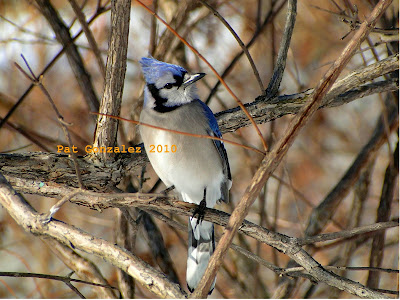 Female Great Horned Owl of the NYBG
Female Great Horned Owl of the NYBG
I received an email today from Carol Capobianco, the Editorial Content Manager at the New York Botanical Garden--
Debbie Becker, who leads bird walks here at The New York Botanical Garden, witnessed a face off between two red-tailed hawks and the great horned owl who is nesting in the Forest. She blogs about it on today’s Plant Talk.
http://www.nybg.org/wordpress/?p=5343
The Red-tails in question were Rose, former mate of Hawkeye of Fordham and the Library NYBG nests. And the Great Horned Owls were those who have nested in the NYBG for some years. The male in particular, I understand has been there at least a decade if not longer.
 Male Great Horned Owl of the NYBG
Male Great Horned Owl of the NYBG
It is interesting that though we try to observe this sort of possible life and death situation in an unbiased manner , the folks at the NYBG were definitely on the side of the owls and we, who have watched Rose raise her families for some years cannot help but fear for the Red-tailed Hawks.
Do read the first hand account at the link above and as I thought there might be some inconsistencies with my knowledge at that possibly espoused by the writer, I contacted John Blakeman for some of his experienced advice.
I don't see the interaction as a form of pack hunting but more in the vein of the typical double defense often seen in Red-tailed Hawks when they feel endangered. In this case it looked to me like a preventative strike. The Red-tails might well have reason to fear the Great Horned Owls.
I have read of incidents in which Great Horned Owls will predate the nest of Red-tailed Hawks and have the eyasses for a midnight snack if possible. They being nocturnal. A couple of years ago, a Red-tailed Hawk was found dead in the garden and the thought was he had been killed by the GHOs.
In researching this issue, I found one entry in which it said that Red-tails will also predate the young of GHO nests. Personally I'd think there were easier meals to forage for but perhaps that was also a preventative strike as might be the predation of RTH nests by GHOs.
As far as I can tell neither act is all that common, though there was more information on the GHO's being the predators available which would lead me to believe that as humans are less likely to be watching at night, and humans are reporting the events, that the predating of young Red-tails is more common act.
Ms. Becker feared that Rose and her immature friend were more dangerous to the Owls than the other way around because they had stronger beaks than did the Great Horned Owls. But as we know Red-tailed Hawks rarely use their beaks in attack, it is the talons that do the work. And as it turns out, the talons of a Great Horned Owl are far more dangerous than those of a Red-tailed Hawk.
I read a report concerning just this thing. Red-tailed Hawks rarely if ever go after house cats, they just haven't the strength in their feet to make successful kills whereas Great Horned Owls appear to have no trouble at all in removing tabbies from the landscape.
Ms. Becker and her fellow birdwatchers eventually disrupted the interaction for fear of the Owls being hurt. Perhaps Rose had concrete reasons for her preventative strike in that there had been forays from the owls during the night when humans weren't observing the interaction, I don't know. Or if the immature bird with her was not one of the previous year's young, but rather a very young mate (Pale Male first mated as a brown-tail), she might well fear that her mate was not yet up to doing his full share during a night raid, she felt it necessary to do a day raid to protect her future young.
On the other hand, a female owl sitting eggs makes a reasonably easy target if she is sitting tight and the male is not at hand to help in her defense, but in this case he was at hand
Of course the whole thing could also be put down to a display of strength on the RTHs part to let the owls know they just weren't a couple of push overs and that detente should be the order of the day.
Time may tell us just what they were hoping to accomplish. I'm hoping it was detente for everyone's sake, the birds and the humans who watch them included.
Re: The nest found near the Rock River in Beloit, WI featured on a previous blog.
 Courtesy of http://www.illinoisraptorcenter.org/diaryphotoalbum6.html
Courtesy of http://www.illinoisraptorcenter.org/diaryphotoalbum6.html
And example of a Baltimore Oriole nest--it appears to be more of a drawstring like purse shape.
 Whereas the Orchard Oriole nest appears to be rounded with a wider opening at the top. I saw some examples in which the nest actually rested in the crouch of several twigs.
Whereas the Orchard Oriole nest appears to be rounded with a wider opening at the top. I saw some examples in which the nest actually rested in the crouch of several twigs.
Donegal Browne



























































